1. Introduction
 Abit’s name is undoubtedly one of the most prestigious in the world of motherboard production.
For many years, Abit’s products were synonymous with over clocking.
So it wasn't a surprise that they would once again release motherboards with advanced overclocking capabilities.
Abit’s name is undoubtedly one of the most prestigious in the world of motherboard production.
For many years, Abit’s products were synonymous with over clocking.
So it wasn't a surprise that they would once again release motherboards with advanced overclocking capabilities.
The new AN8 32X is a board for AMD's socket 939 processors with 2GHz HT and also incorporates Nvidia's NF4 SLI X16 chipset. It further supports Dual DDR 400, NV SATA RAID, NV GbE w/Firewall, 7.1 CH Audio, NVIDIA SLI Tech., ABIT Silent OTES, ABIT µGuru Tech.

- Specifications
| CPU |
- Supports Socket 939 Athlon64/ 64FX/ 64X2 Processors with 2GHz system bus using Hyper Transport™ Technology
-
Supports AMD CPU Cool 'n' Quiet Technology |
| Chipset |
NVIDIA® NF4 SLI X16 / NF4 SLI Chipset |
| Memory |
- Four 184-pin DIMM sockets
-
Supports Dual channel DDR 400 ECC/non-ECC un-buffered memory
-
Supports maximum memory capacity up to 8GB |
| NVIDIA SLI Technology |
- Two PCI-Express X16 slots support NVIDIA Scalable Link Interface
-
Two full-bandwidth 16-lane PCI Express |
| NV SATA 3Gb/s RAID |
- Supports 4 ports SATA 3Gb/s RAID 0/1/0+1/5
-
Supports SATA AHCI, providing native command queuing and native hot plug |
| 2nd SATA RAID |
- Serial ATA 3Gbps by Sil 3132 PCIE controller
-
Supports SATA RAID 0/1 NCQ |
| Audio |
- On board 7.1 CH Audio CODEC (ALC850)
-
Supports auto jack sensing and optical S/PDIF In/ Out |
| NV GbE |
NVIDIA® Gigabit Ethernet with NV Firewall ActiveArmor |
| IEEE1394 |
Supports IEEE1394a |
| Internal I/O Connectors |
- 2 x PCI Express x16 (two full-bandwidth 16-lane PCI Express)
- 2 x PCI Express x1, 2 x PCI slots
-
1 x Floppy port supports up to 2.88MB
-
6 x SATA connectors
-
2 x Ultra DMA 133/100/66/33 connectors
-
3 x USB 2.0 headers, 1 x IEEE 1394 header
-
1 x Guru Link |
| Back Panel I/O |
- 1 x PS/2 Keyboard, 1 x PS/2 Mouse
-
4 x USB ports, 1 x RJ-45 LAN port, 1 x IEEE 1394
- 1 x S/P DIF In, 1 x S/P DIF Out |
| Form Factor |
ATX form factor 305 x 245mm |
| ABIT Engineered |
- ABIT Patented Silent OTES™ Technology*
-
ABIT µGuru™ Technology |
| Compatible Accessories |
Guru Clock |
*Patent No. M273189
*V3.x and above ROhs compliant
- Retail Package

The retail package includes:
- 1 x SLI connector
- 1 x SLI bracket
- 6 x SATA cables
- 1 x 2-port USB2.0 / IEEE1394 port module
- 1 x UltraDMA 133/100/66 cable
- 1 x FDD cable
- 1 x I/O Shield
- User' s manual
- Quick Installation Guide
- μGuru utility manual
- 1 x CD with drivers and utilities
- 4 x disks with drivers
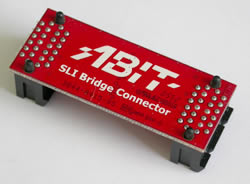

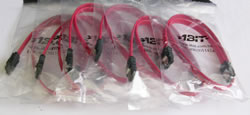
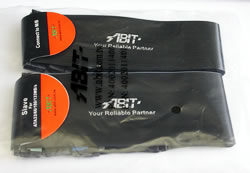

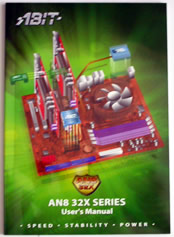
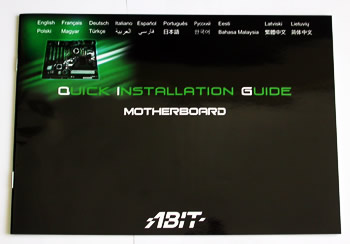

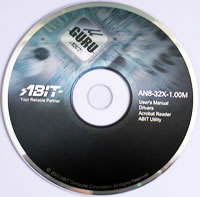
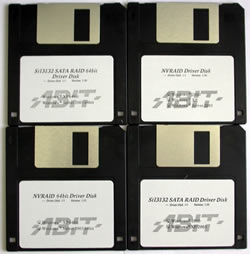
2. A Closer Look
The AN8 32X is manufactured on an orange PCB. The interface connections are layed out so as to make them easily accessible and the colour coding helps in identifying them.



The AN8 32X is a 939 socket based motherboard.
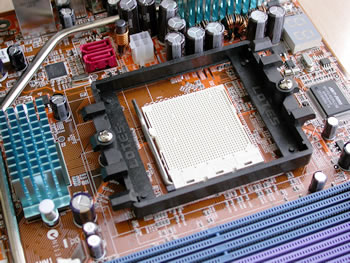
The board adopts a silent cooling system, called SILENT OTES, using three independent heatsinks, with those on the Southbridge and Northbridge being connected through a pipeline.



The AN8 32X has four 184-pin DIMM sockets
and supports Dual channel DDR 400 ECC/non-ECC un-buffered memory
with a maximum memory capacity up to 8GB. Each channel is a different color. So if you want to install two modules in Dual Channel, you'll have to install both in either the blue or the purple sockets.
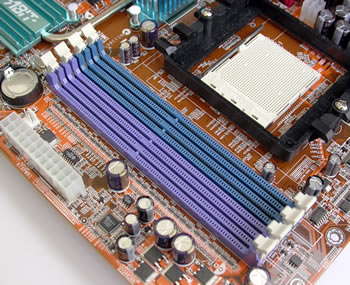
The board also has two IDE connections located on the edge of the board and with the pins parallel to the board, something common amongst motherboards nowadays.
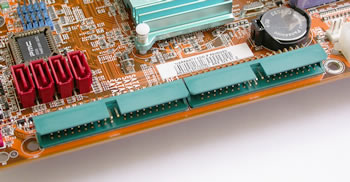
The AN8 32X provides six SATA connections :
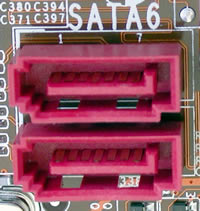

There are also additional USB and Firewire connections on the motherboard:
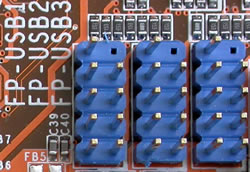

The 24pin power connector:

For supplying the fans with power, ABIT equipped the AN8 32X with five power connectors:
The entire series of chipsets on the motherboard:
The AN8 32X, as with many of the latest ABIT motherboards, has a Power On Self Test (POST) Code Display. The computer will execute a POST whenever you power on the computer. The POST process is controlled by the BIOS. It is used to detect the status of the computer's main components and peripherals. Each test in the POST process corresponds to a different checkpoint that is also defined by the BIOS in advance.


The connections provided on the AN8 32X are :
- 1 x PS/2 Keyboard
- 1 x PS/2 Mouse
- 4 x USB ports
- 1 x RJ-45 LAN port
- 1 x IEEE 1394
- 1 x S/P DIF In
- 1 x S/P DIF Out
3. Test System
- Processor: AMD 64 3500+
- Case: Thermaltake Matrix
- Motherboard: ABIT AN8 32X, MSI K8N DIAMOND
- Graphics Card: 2X ASUS N6600GT SLI
- Memory: 2x512MB Corsair CM2X512-8000UL
- Hard Disk Drive: WD800JD 80GB 7200RPM
- DVD Burner: LG GSA-4163B
- Power Supply: Thermaltake PurePower 520W
- OS: Microsoft WindowsXP Pro SP2
- DirectX: v9.0c
- nVidia Drivers: version 81.98
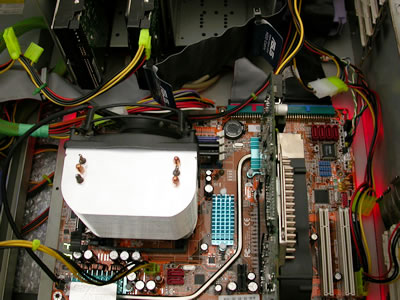
Benchmarking Software
3DMark05,03,01
PCMark04, 05
Codecreatures Benchmark Pro
AquaMark3 v3.0
Performance Test V5.0
Half Life 2
Quake 4
F.E.A.R
Need For Speed - Most Wanted
In this review, we will be testing the performance of the ABIT AN8 32X board. For comparison, we will also post the results for the MSI K8N Diamond. As soon as we receive the MSI K8N Diamond PLUS and the ASUS A8N32 SLI Deluxe, we will provide a roundup review.
4. 3DMark2005
 With 3DMark05, Futuremark continues its tradition in benchmarking software by providing a state-of-the-art Microsoft ® DirectX ® 9 3D performance benchmark.
With 3DMark05, Futuremark continues its tradition in benchmarking software by providing a state-of-the-art Microsoft ® DirectX ® 9 3D performance benchmark.
3DMark05 is an all new 3DMark version making the most of Microsoft's DirectX
9. The previous version 3DMark03, did a nice introduction into this level
of technology. However
3DMark03 used DirectX 9 specific features in a limited manner, because fully
supporting hardware was rare at the time of its launch. In contrast, 3DMark05
requires DirectX 9 hardware with full support for at least Shader Model 2,
and takes shader usage to never before seen levels.
Just like its predecessors, 3DMark05's point system is set so that at the
moment of release, the high-end VGA cards available in stores can only score
around 5000 3DMarks, whereas the worst card that meets the programs requirements
yields a score of 1000.
Game Test 1 -Return to Proxycon
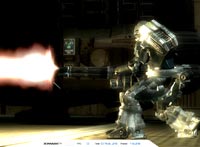 Being the sequel to the "Battle of Proxycon"
from 3DMark03, in "Return to Proxycon" we're once again set in space
and the battle continues as space pirates invade a cargo ship in order to
take control of its valuable cargo.
Being the sequel to the "Battle of Proxycon"
from 3DMark03, in "Return to Proxycon" we're once again set in space
and the battle continues as space pirates invade a cargo ship in order to
take control of its valuable cargo.
This test, tries to simulate a future first-person shooter game with all the high details that entails. The dynamic shadows, high-detailed environment and advanced lighting techniques ensure that under normal circumstances, no recent card can run it with decent frame rates.
Game Test 2 - Firefly Forest
 A forest gets filled with magic fireflies in the night. The moon is nearly full, illuminating the forest with a bluish faint light. The magic fireflies have flickering bright green lights that playfully move around the forest.
A forest gets filled with magic fireflies in the night. The moon is nearly full, illuminating the forest with a bluish faint light. The magic fireflies have flickering bright green lights that playfully move around the forest.
This scene is a nice example of a smaller scale outdoor scene with rich vegetation. Immediate visibility is not so far, and there is a skybox surrounding the whole scene.
A large number of trees with their branches swinging separately, and dense vegetation being dynamically distributed according to the camera movements, make this test the most demanding of the three.
Game Test 3 - Canyon Flight
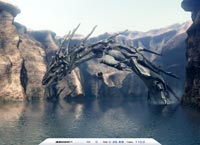 A Jules Verne type airship flies through a canyon guarded
by a dangerous sea monster. The airmen defend their ship using heavy cannons,
but these seem to have no effect on the huge sea monster. Finally the crew
manages a narrow escape using the "last resort" afterburners of
the airship.
A Jules Verne type airship flies through a canyon guarded
by a dangerous sea monster. The airmen defend their ship using heavy cannons,
but these seem to have no effect on the huge sea monster. Finally the crew
manages a narrow escape using the "last resort" afterburners of
the airship.
This scene is fairly complex with large areas of water
reflecting the high canyon walls. The water actually is one of the key points
of interest in this scene. The water not only does realistic looking reflections
and refractions, it has a depth fog, making the sea monster swimming under
the airship actually look deep down in the water. The air in this scene also
uses a volumetric fog, making distant cliffs of the canyon really look far
away.
Almost identical results for both NForced4 based boards in the GT2 and GT3 tests, while with GT1, the P5N32-SLI is slightly better. It seems that 3DMARK05 does not make use of the X16 dual, therefore there's no great difference in performance.
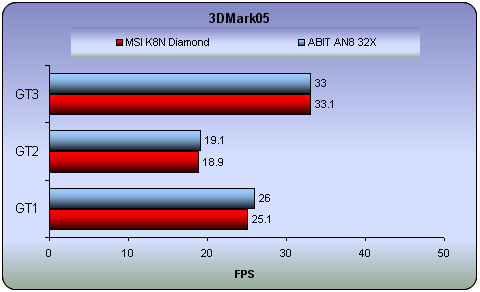
You could say similar results from both motherboards. However, the slight difference as far as framerate is concerned, is enough in 3DMark05 to award the ABIT board a higher score.
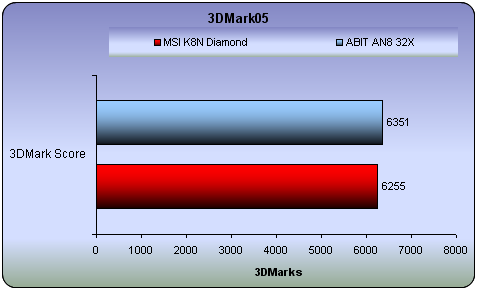
5. 3DMark2003
 3D Mark is a widely used and accepted benchmark that stresses the DirectX performance of a VGA card. A very strong point of 3DMark is that it's VGA card measuring is does not require any CPU power. So the resulting fps are a good reference a VGA card's rendering performance. For testing the performance of each card we used the 4 game benchmarks 3DMark has.
3D Mark is a widely used and accepted benchmark that stresses the DirectX performance of a VGA card. A very strong point of 3DMark is that it's VGA card measuring is does not require any CPU power. So the resulting fps are a good reference a VGA card's rendering performance. For testing the performance of each card we used the 4 game benchmarks 3DMark has.
3Dmark03 also includes sound and CPU tests as well as some other feature tests.
If you test your machine with 3DMark, you can post the results at 3DMark's online result browser. For more information, visit futuremark.com.
- Game Test 1 - Wings of Fury (DX7)
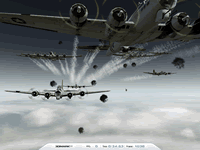
This test is a combat flight simulator written for older hardware (DirectX 7). Particles are used a lot in this test - smoke and vapor trails, flak and gunfire, and explosions are produced using point sprites and quads.
- Game Test 2 - Battle of Proxycon (DX8)

This test is a simulation of first person shooter game types. 1.1 and 1.4 Vertex shaders are widely used since all character models are skinned using vertex shaders.This makes this test a good vertex shader comparison for VGA cards.
- Game Test 3 - Trolls' Lair (DX8)

This test should be the favorite of all RPG lovers. It is a cut scene of a female warrior facing two malicious trolls. Again the same vertex and pixel processing is used as in game test 2.
This test also uses post-processing effects, such as Depth of Field and Bloom effects which are widely used in today's game cut scene sequences.
- Game Test 4 - Mother Nature (DX9)

Mother nature represents the level of effects and realism that are possible using 2.0 vertex and pixel shaders, plus some other features that DirectX 9 offers.

There is a huge difference in the fourth game's framerate, where the ABIT AN8 32X reported 22fps more than the MSI motherboard. However, this was not enough to give it an overall higher 3DMark03 score, where the score for both boards is very close.
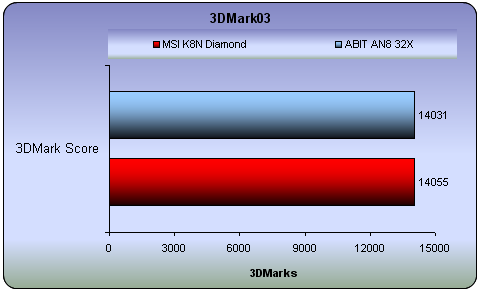
6. Codecreatures
 CodeCreatures is a synthetic 3D benchmark that is a good reference for VGA performance comparison. This is a high-end 3D benchmark that also requires DirectX 8 hardware, making a good tool for measuring the potential of DirectX 8 game performance.
CodeCreatures is a synthetic 3D benchmark that is a good reference for VGA performance comparison. This is a high-end 3D benchmark that also requires DirectX 8 hardware, making a good tool for measuring the potential of DirectX 8 game performance.
The Codecreatures benchmark is written with Microsoft's DirectX 8.1 API and incorporates the use of Vertex and PixelShaders popular on next generation 3D accelerators.

The benchmark plays a photo-realistic nature scene and calculates the performance of the graphics adapter by measuring the fps that it can display at 1024x768, 1280x1024 and 1600x1200 resolutions.
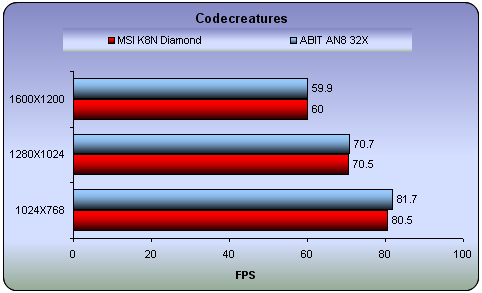
Slightly better performance and higher framerates for the ABIT motherboard had as a result, a higher overall score.
-Codecreatures number
The codecreatures number is the resulting score of the total
benchmarking process and is basically the geometric mean of the three frame
rates multiplied by 100.
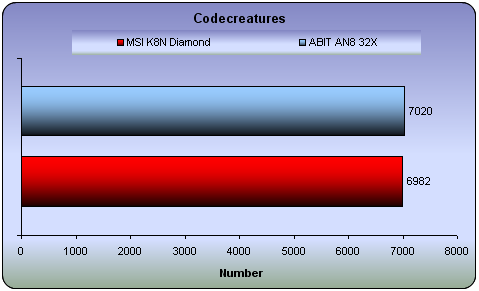
7. Aquamark - 3DMark01
 Since the majority of today's applications and games are compatible with DirectX 9, the need of benchmark applications that use DX 9 has been brought up. The benchmark uses the 3D engine (Krass engine) of the Aquanox game.
Since the majority of today's applications and games are compatible with DirectX 9, the need of benchmark applications that use DX 9 has been brought up. The benchmark uses the 3D engine (Krass engine) of the Aquanox game.
Aquamark Triscore
The Aquamark Triscore comprises 3 values: the overall system performance, the performance of the graphics system and the CPU performance. Keep in mind that this is not the total result of the tests, but the result of the whole benchmark process including all 9 chapters.
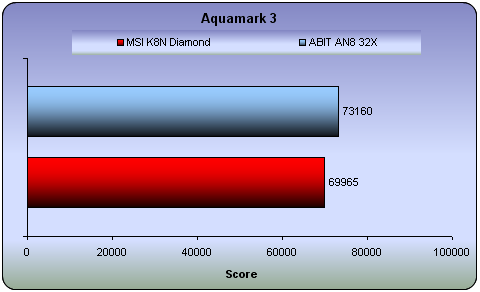
Both graphics and CPU performance was better with the ABIT board, and hence the large difference in the scores between the ABIT and MSI motherboards.
3DMark 2001
3DMark 2001 is the predecessor to 3DMark03. It's mainly a directx8.1 benchmark and the score depends a lot on the CPU power of your computer. However for reference use only we decided it'd be best to just leave it in our benchmark list so you can compare the next generation cards with the possibly outdated you have at home.
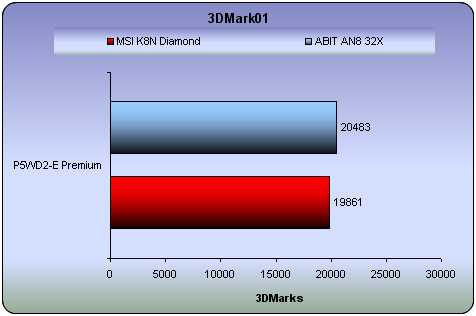
The overall performance from the ABIT motherboard is better in this benchmark as well, even though this is an "old" benchmark and does not take advantage of the full capabilities of the dual x16 board.
8. Half Life 2
Half life 2 is no doubt the most anticipated pc game of all times. Gamers keeping the excellence of Half Life 1 in their mind as well as the remarkable E3 demo preview, have been anxiously waiting for the much delayed release of HL2.
 Characters - Advanced facial animation system delivers the most sophisticated in-game characters ever seen. With 40 distinct facial "muscles," human characters convey the full array of human emotion, and respond to the player with fluidity and intelligence.
Characters - Advanced facial animation system delivers the most sophisticated in-game characters ever seen. With 40 distinct facial "muscles," human characters convey the full array of human emotion, and respond to the player with fluidity and intelligence.
Physics - From pebbles to water to 2-ton trucks respond as expected, as they obey the laws of mass, friction, gravity, and buoyancy.
 Graphics
- Source's shader-based renderer, like the one used at Pixar to create movies
such as Toy Story® and Monster's, Inc.®, creates the most beautiful
and realistic environments ever seen in a video game.
Graphics
- Source's shader-based renderer, like the one used at Pixar to create movies
such as Toy Story® and Monster's, Inc.®, creates the most beautiful
and realistic environments ever seen in a video game.
AI - Neither friends nor enemies charge blindly into the fray. They can assess threats, navigate tricky terrain, and fashion weapons from whatever is at hand.
To measure performance we used the Video Stress Test(VST) that is available in the CounterStrike:Source beta available through Steam. We set all the details to the highest level and each time changed the resolution from 800x600 up to 1600x1200.

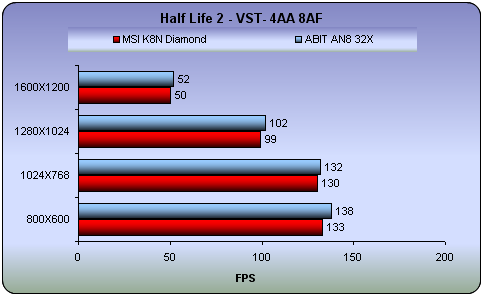
The game more closely approaches reality, and for many people it is the the measure by which all other games are judged. If you chose the ABIT AN8 32X, you'll get better performance here. No matter what the resolution or the advanced filter settings, our CPU and graphics cards performed better with the ABIT motherboard.
9. Quake 4
 In a desperate war for Earth's survival, against an unrelenting alien enemy, the only way to defeat them is to become one of them. Armed with advanced weaponry and vehicles and aided by an elite squad of marines, you take the battle to the heart of the Strogg home planet and become Earth's only hope for victory.
In a desperate war for Earth's survival, against an unrelenting alien enemy, the only way to defeat them is to become one of them. Armed with advanced weaponry and vehicles and aided by an elite squad of marines, you take the battle to the heart of the Strogg home planet and become Earth's only hope for victory.
Quake 4 is a First Person Shooter developed by Ravensoft, based on the Doom 3 engine, and the graphics and gameplay certainly reflect that fact. For those who really hated the one-way corridors of Doom 3, new outdoor areas have been added to the game. The feeling however, still remains the same as these areas are quite small-scale, contrary to what other games have to offer.
- Benchmark Settings

As Quake 4 includes no default benchmark, we decided to go with another publicly available demo to measure performance. What we chose is a demo from HWSpirit, which involves a small outdoor scene followed by a long indoor combat. As preloading the stage once again failed miserably and the average framerate varied a lot, we ran it twice every time, restarting the game and measuring only the second run.

The resolutions we used are 800x600, 1024x768, 1280x1024 and 1600x1200. We measured performance with and without Anti-aliasing and Anisotropic Filtering.
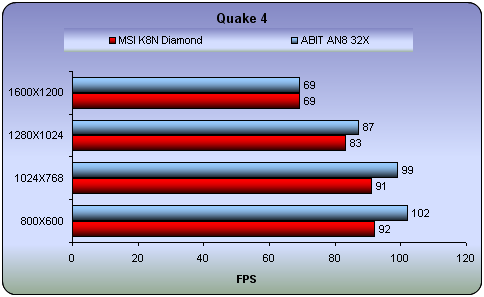
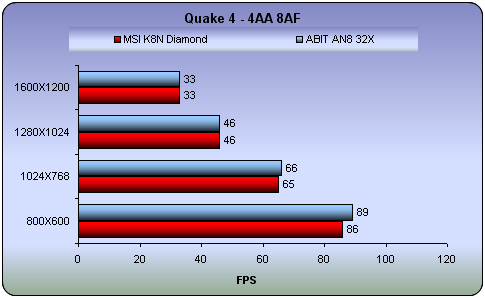
Quake4 is a rather new game and its demands from a system are high. There were cases where the ABIT motherboard reported 10fps higher performance than the MSI.

10. F.E.A.R.
 You aren't a soldier. You are a weapon. A paramilitary force infiltrates a multi billion dollar aerospace compound taking hostages, but issuing no demands.
You aren't a soldier. You are a weapon. A paramilitary force infiltrates a multi billion dollar aerospace compound taking hostages, but issuing no demands.
The government responds by sending in its best special operations teams, only to have them obliterated. Live footage of the massacre is cut short by an unexpected wave of destruction that leaves military leaders stunned and in disbelief.
First Encounter Assault Recon (F.E.A.R.) is one of the new-generation FPS. The graphics are really stunning, the plot behind the whole shooting successfully keeps it interesting and even the A.I. seems to work out well.
F.E.A.R. offers a lot to the First Person Shooter world. The graphics are very clear with excellent textures, great new effects that will stress your graphics card and ragdoll physics that are waiting to be exploited as you progress through the game.
- Benchmark Settings
F.E.A.R. allows you test the video settings on a mini-benchmark involving a lot of weapon firing, explosions and several other effects. After the benchmark is run, you're presented with a screen showing your minimum, average and maximum framerates and also percentages of how often the framerate was below 25fps, between 25 and 40, and finally above 40. For this presentation, we're just sticking to the minimum and average framerates.

The resolutions we used were 800x600, 1024x768, 1280x960 and 1600x1200. We measured performance with high and highest details.
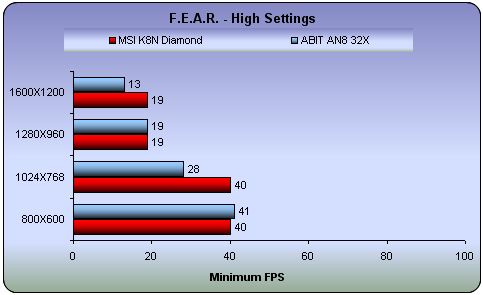
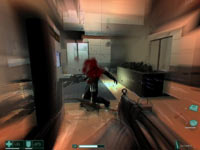
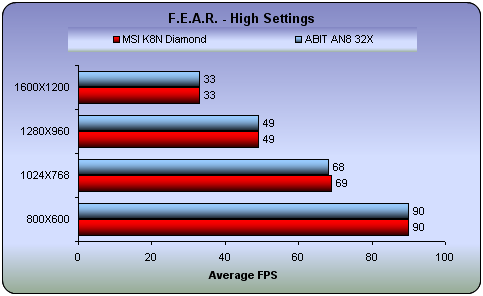
Almost identical performance from both motherboards. This is the only case where this happened.
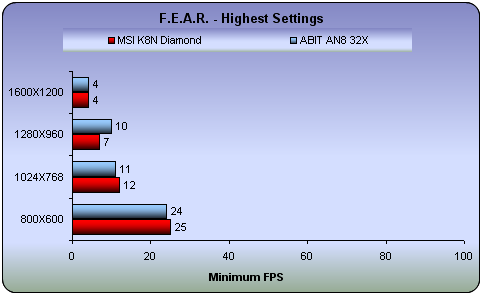
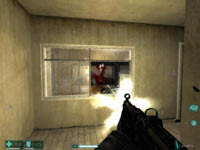
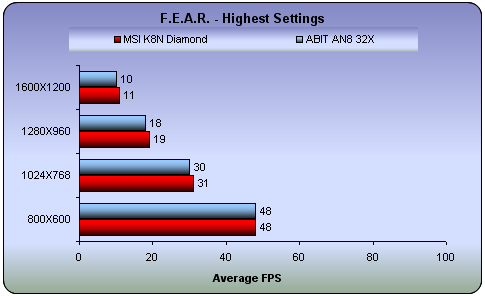
One fps is not really a difference and we would say that the performance in this game was identical for both ABIT and MSI.
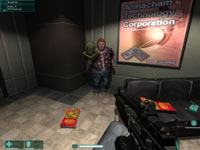
11. Need For Speed - Most Wanted
 Wake up to the smell of burnt asphalt as the thrill of illicit street racing permeates the air.
Wake up to the smell of burnt asphalt as the thrill of illicit street racing permeates the air.
Combining illicit street racing and tuner customization with the intensity of strategic police pursuit that surpasses any Hollywood-style chase scene, Need for Speed Most Wanted will be on every gamer's 'must-have' list this holiday season. Out-race rivals, evade cops and exploit hundreds of miles of open road as gamers make their way up the Blacklist.
To become the most wanted racer, players must build up their street cred and Rap Sheet with gripping, white knuckle, head-to-head races with the top drivers on the streets, as well as pull daring, evasive moves to out-run and out-fox the cops that patrol the open road. Players can manage their heat or utilize a number of strategic tactics to keep the cops off their tails as they leave their rivals behind to suck their exhaust fumes.

- Benchmark Settings
NFS Most Wanted includes no default benchmark. To measure the card's performance, we've chosen to record the framerate at the start of a circuit race with end-game cars. The starting point tends to be one of the most graphically demanding parts because of the smoke coming from spinning wheels added to the rest of the game's visual effects. If a card can pass this step with an acceptable framerate, it is guaranteed that it will face no problems with the rest of the game.

The resolutions we used are 800x600, 1024x768, 1280x1024 and 1600x1200. We measured performance at the lowest and highest possible settings.
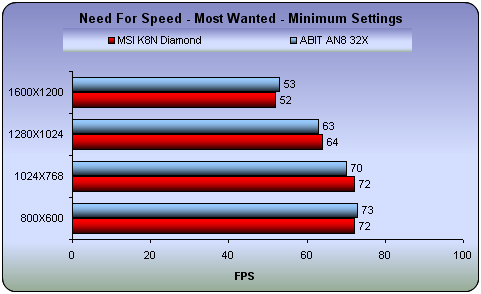
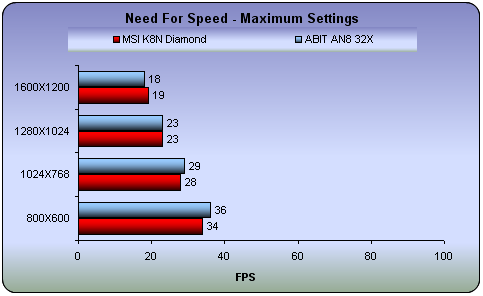
Once again, similar results from both motherboards.

12. Performance Test v5.0
The suite of the PassMark Performance Test contains a number of suites with different tests to measure different aspects of a computer system.
The "PassMark rating" is a weighted average of all the other test results and gives a single overall indication of the computers performance. The bigger the number, the faster the computer. The "PassMark rating" can only be calculated if the results from all other tests are available. The value is calculated as follows.
| Test Suite |
Weighting |
| Disk |
20% |
| CD / DVD |
9% |
| Memory |
18% |
| 3D Graphics |
12% |
| 2D Graphics |
14% |
| CPU |
27% |
| Total |
100% |

The ABIT motherboard produced a rather sizeable difference in the score, from its MSI counterpart in this Performance Test.
13. PCMark04 - 05
PCMark04 and 05 are application-based benchmarks and a premium tool for measuring overall PC performance. It uses portions of real applications instead of including very large applications or using specifically created code. This allows PCMark05 to be a smaller installation as well as to report very accurate results. As far as possible, PCMark05 uses public domain applications whose source code can be freely examined by any user.

Both PCMark04 and PCMark05 include 5 categorized suites for benchmarking your computer. These include System, CPU, Graphics, Memory and a Hard Disk Drive benchmark. In our case, we selected the system test suite which integrates tests included in the other categories.
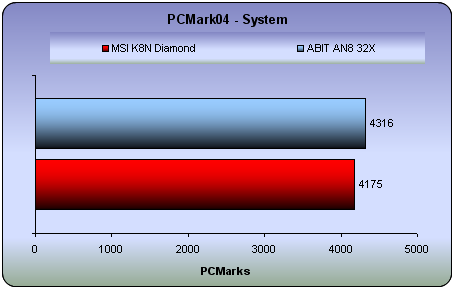
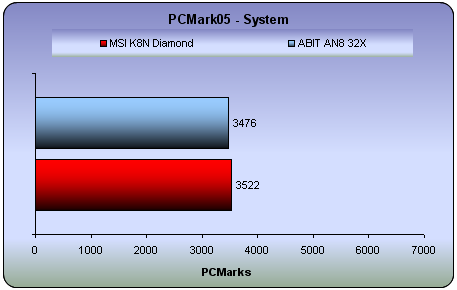
Our system's performance was much better with the ABIT board under PCM04, while when we ran PCM05, the MSI motherboard edged slightly in front.
14. Guru Utility
The included CD includes the μGuru Utility, a helpful application for overclocking your system, as well as monitoring the temperature and voltages from the OS.
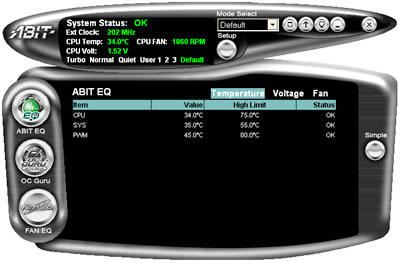
In Full Mode

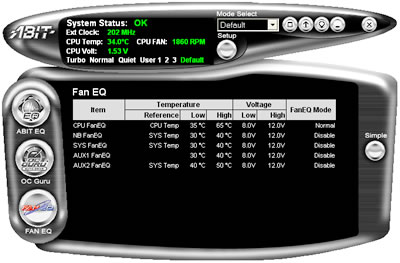

In Simple Mode

There are some preset overclocking profiles which you can use to overclock your system. Moreover, there are three modes where you can create and save your own overclocking profile.
Enter the Settings Menu:

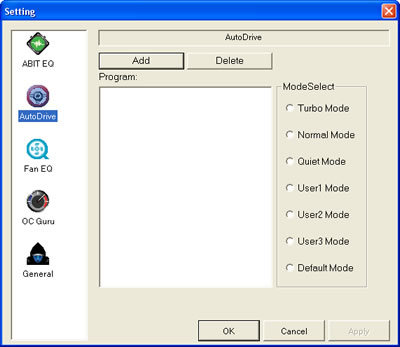
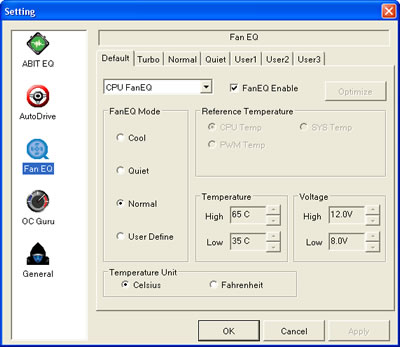
From here, you can check preset overclocking profiles, or create and save your own. You can also manually set the FSB speed for the processor, the PCIE speed, the CPU Core and DDR Voltages.
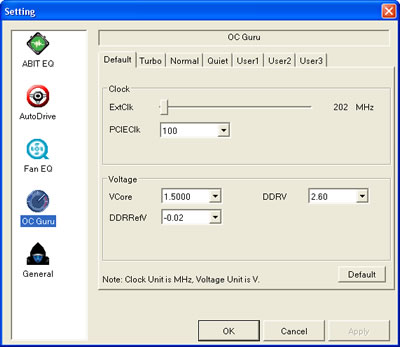
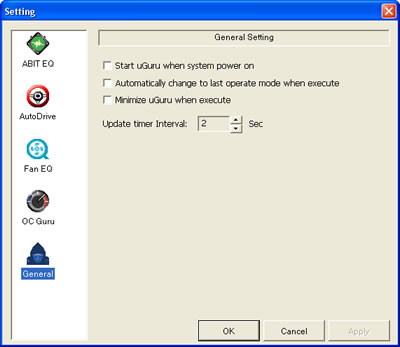
15. Bios - Page 1
Below you can see snapshots from the BIOS screens.

ABIT Logo screen
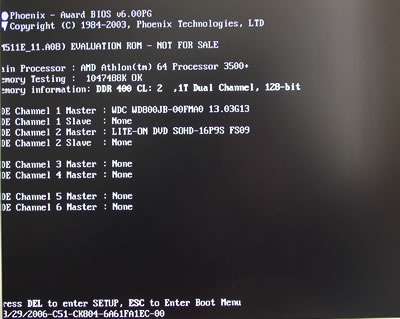
Boot screen
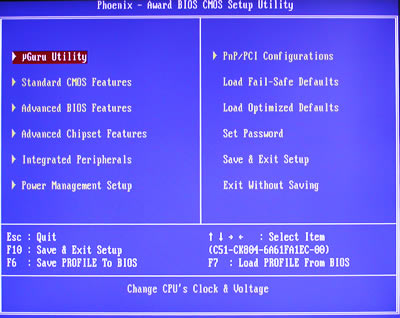
Bios main Screen

µGuru Utility





16. Bios - Page 2
These are BIOS features for advanced use, including overclocking:
From the Advanced Features tab, you can configure the DDR memory.

Set between Auto, SPD or Manual memory timings.
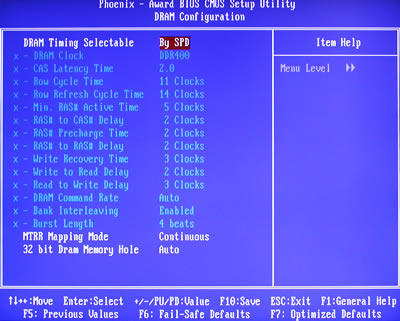
If you set to Manual then you'll be able to set the timings as well...

...or the memory speed.

At this point, we would like more than just the four preset speed modes. For example, the ability to increase the speed step by step.
The μGuru utility will help you to overclock your system. Set it to "User Define" and change the Multiplier as well as the External Clock, meaning the FSB speed. An increase in the CPU Core Voltage and DDR Voltage is required for higher stability. The board can provide the memory with voltages up to 3.20 V and the CPU up to 1.90 V.

This μGuru utility will also help you to monitor the temperatures for your system as well as the fan speeds and voltages.
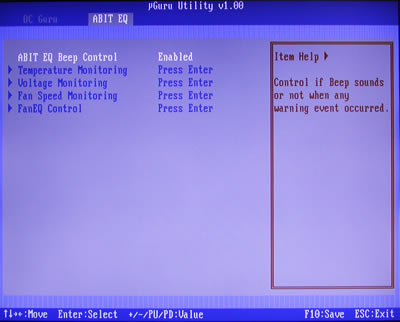


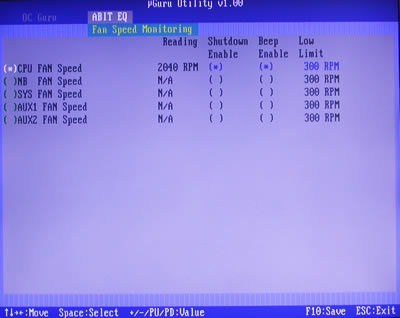
17. Software CD
The Software CD included in the retail package includes the following:
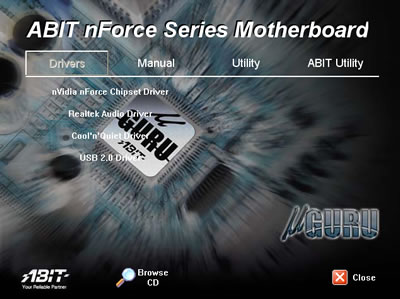
Drivers

Manual
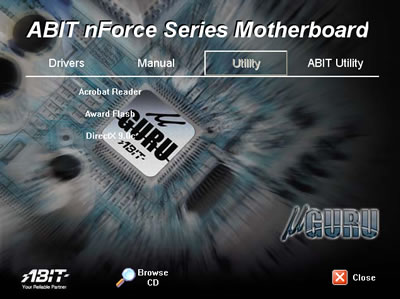
Utilities
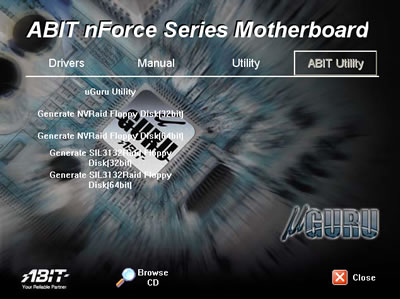
FlashMenu is a very helpful utility which helps locate the appropriate firmware revision for the motherboard and then flashes it.

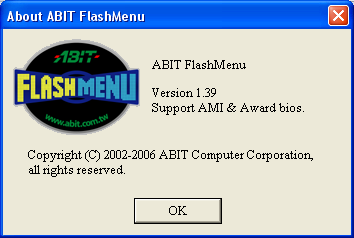
As soon as a new firmware is found, you can download it and flash the board with it.
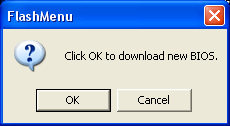
18. Overclocking
The μGuru utility is a convenient utility to help overclock your system. There is no need to enter into the BIOS with this utility, although we still think the BIOS is still the safest way to go.
First, we selected the Turbo preset profile.

The changes were made immediately, without any restart being required.
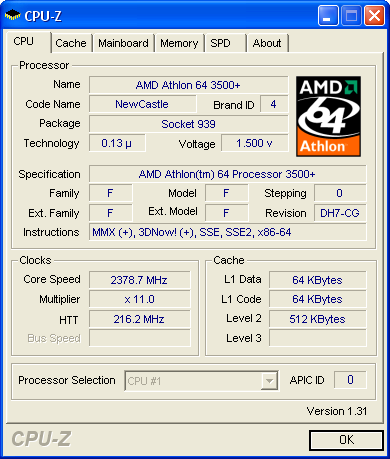
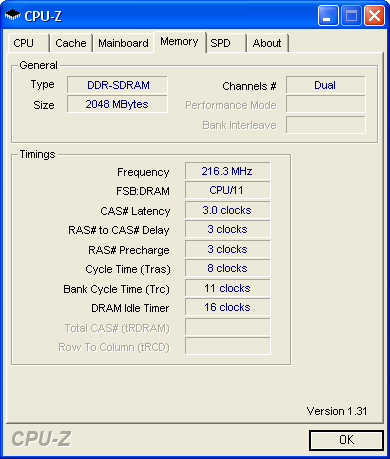
Afterwards, we manually set the FSB speed and voltages through the μGuru utility, by creating and saving our own profile.

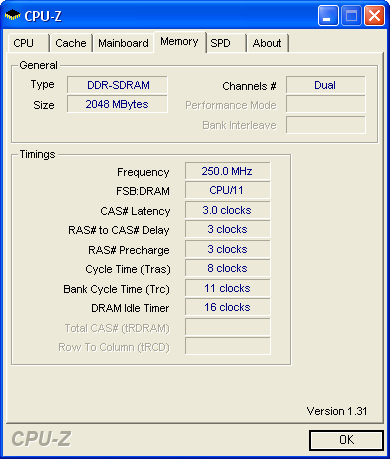
A great way to overclock your system. However, don't over do it, because your system will become unstable and can lock up or even reboot.
19. Conclusion
The ABIT AN8 32X with its orange colored PCB and its quality of construction, comes in a rather good retail package with all appropriate cables and manuals included. Dual X16 PCI-Express and SLI support, Gigabit LAN, 7.1 CH Audio with two optical/digital connections, double SATA RAID, Dual Channel, are only some of the board's features. Maybe a WireLess LAN or a second onboard LAN are something we would like to see. The Silent Otes fanless cooling, is rather impressive and effective too. We also liked the POST Code Display, something you won't find often, even on the most expensive motherboards and don't forget, the μGuru utility which will help you to easily overclock your system.

The performance of the AN8 32X is good. However, we should mention that the capabilities of this platform, with its two PCI-Express X16 slots, are greater than the demands of current games. In our benchmarks, our CPU, VGA cards and other components, seemed to prefer the AN8 32X and reported better overall performance with it over the MSI K8N Diamond.
This is a motherboard which you can keep for a long time.

The price at the time of this review was US$185 on the e-market which is among the more expensive motherboards.
Pros:
- Dual X16 SLI support
- Great features
- Good Retail Package
- Very Good performance
- Monitor utility from within Windows
- Very good motherboard overclocking capabilities
Cons:
- No Wireless or Second Lan
Like to be fixed
- Maybe a slightly lower price?
